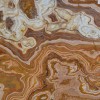Old Florentine traditional Hand-made tiles produced by skilled personal using wet clay mixture worked by hand in mold forms. Each tile is formed personally feeling the touch and the person pressing of hands. These tiles are considered state of art products, as the time required for this production piece by piece takes time and can […]

Polished surface
Due to the hardness and compactness of Cotto Imprunetino – Cotto Il Ferrone, the tiles can go through polishing process which enhances the natural elegance of the “Florentine red” color of the living material and recalls this proposed flooring to its traditional importance in the Florentine architecture. The honed polished surface donate to the Terracotta […]

Rustic surface
A distinctive, uniform “Florentine red” color rusticated tiles surface achieved by dry-brushing the surface of the tiles before firing are the main features of Traditional Rustic Cotto (terracotta). The rustic surface constitutes the most classic type of Florentine products, which enhances the full inner structure, the living material of cotto, and guarantees the evenness of […]

Sestino brick & Tozzetto brick
Sestino and Tozzetto are small bricks destined mainly for paving roads and town squares. The paving in the historical centers of cities such as Assisi, Spoleto, Montepulciano and Certaldo, to mention the most famous ones, are in Cotto Il Ferrone, a material which blends perfectly with the attractive shades of the original colors Exceptional quality […]

Granite
The word granite comes from the Latin granum, a grain, in reference to the coarse-grained structure of such a crystalline rock. Granite is a common widely occurring type of intrusive, felsic, igneous rock which is granular and crystalline in texture. This rock consists mainly of quartz, mica, and feldspar. Occasionally some individual crystals (phenocrysts) are […]

Onyx
Onyx comes through Latin (of the same spelling), from the Greek, meaning “claw” or “fingernail”. With its flesh tone color, onyx can be said to resemble a fingernail. It is by all meanings a very valuable processed material due to its particular formation which donates to each slab from the same stone very different colored […]

Sandstone
Sandstone known also as arenite is a clastic sedimentary rock composed mainly of sand-sized minerals or rock grains. Most of the sandstones are composed of quartz and/or feldspar (a rock that does not contain minerals with important elements including metals) like sand. The sandstones may be any color, but the most common colors are tan, […]

Limestone
Limestone is a sedimentary rock composed largely of the minerals calcite and aragonite, which are different crystal forms of calcium carbonate (CaCO3). Many limestones are composed from skeletal fragments of marine organisms such as coral or foraminifera. Limestone contains often variable amounts of silica which is oxide of silicon known by is chemical formula as […]

Travertine
Travertine is a form of limestone deposited by mineral springs, especially hot springs. Travertine often has a fibrous or concentric appearance and exists in white, tan, and cream-colored varieties. It is formed by a process of rapid precipitation of calcium carbonate, often at the mouth of a hot spring or in a limestone cave. In […]

Marble
The word “marble” derives from the Greek from mármaros, “crystalline rock”, “shining stone”, or perhaps from the verb marmaírō, “to flash, sparkle, gleam”. Marble is a rock resulting from metamorphism of sedimentary carbonate rocks, most commonly limestone or dolomite rock. Metamorphic is derived from the Greek word “meta” denoting a change and “morph” meaning form […]

“EDEL – Brand” brick facade
Its exceptional appearance “NOBLE Baked” is produced by special firing techniques, and the addition of natural minerals. The surface structure of the clinker has an embossed and vivid effect. Shadings are enhanced and create a dynamic play of color. To reinforce this effect, foot- and smooth-sorted clinker bricks are installed irregularly while walling up. Sizes […]

Acoustic bricks
Noises and irritating noise are vibrations which are generated at a source. They occur through the use of energy and progress as sound waves. There are two different types of sound: Impact sound also generates air sound waves. Sound waves spread out like water waves and are reflected when they hit other materials. Airborne sound […]

Terracotta facade
The Terracotta facades are important architectural design elements for representative facades structures. Architects and Designers as well as master builders value the material as interesting architectural language of high quality with broad spectrum of colors which donate interest as well as admiration. GIMA had developed concepts for the contemporary production of durable terracotta facades in […]

Klinker facing bricks
The facing brick is a brick that has been burned to sintering, which must have water absorption = 7% and which naturally must be frost-resistant. GIMA facing brick have proven to be ideal facade materials relative to the pollution and aggressive substances in the air today. The dense, closed surface of GIMA facing brick ensures […]

Klinker bar format
The klinker bar format extruded brick is vertically perforated facing material. The Bar format is a proven and tested quality product from Gima that far exceeds the minimum requirements of DIN 105 and/or EN 771-1. The horizontal lines of the constructed area are emphasized by the longitudinal lines created by the bricks, donating a very […]

Euro-module Klinker
Euro-Module formats are made by Gima for the optometric modular coordination (in increments of 250 mm), in the deciraster (with 100 mm increments, also called EURO module) and in the office extension planning module (with 440 mm + 10 mm joint). Planning in deciraster is simple, there are no complications. In the frequently used formats […]



